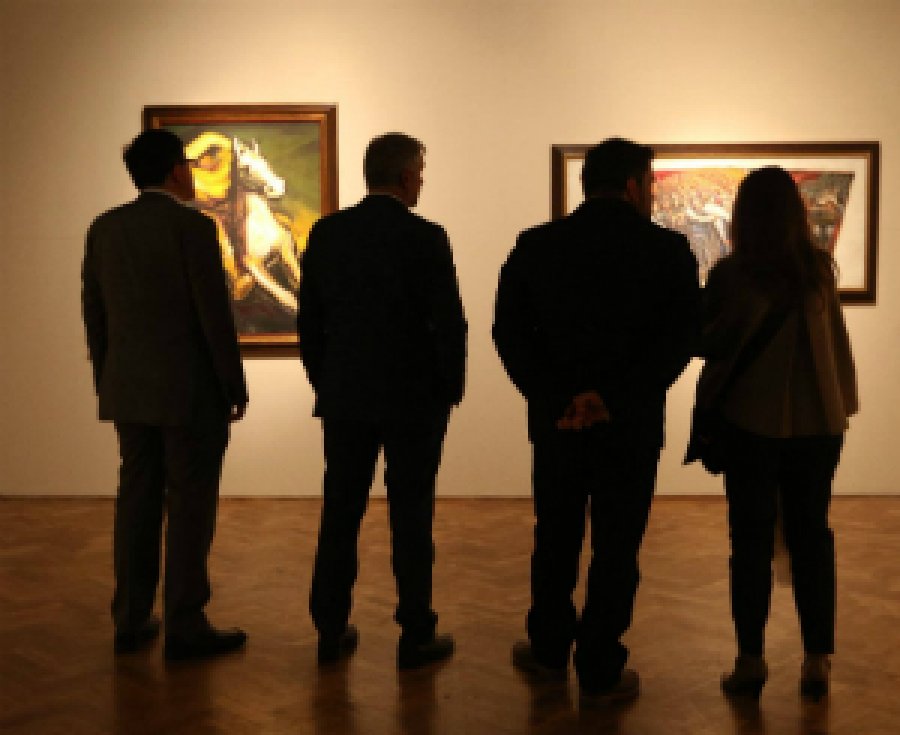Noticias
At the National Museum of Fine Arts
Mexican collection of works by Rivera, Orozco and Siqueiros is exhibited in Chile
November 20, 2015Seventy-six works, by the three great Mexican muralists, José Clemente Orozco, David Alfaro Siqueiros and Diego Rivera, coming from the collection of Carrillo Gil Art Museum, are part of the pending exhibition 1973-2015 that the Museo Nacional de Bellas Artes (MNBA) National Museum of Fine Arts, will house in Santiago de Chile.
The exhibition, Orozco, Rivera, Siqueiros. Mexican Painting, was scheduled on September 13, 1973, which would show the Chilean public one of the most important collections of modern art in the continent, but was thwarted by the military coup to the government of Salvador Allende on September 11.
After 42 years and to celebrate the 25th anniversary of the restoration of diplomatic relations between Mexico and Chile, both governments made a concerted effort to re-edit the exhibit with a selection of 76 works of 180 pieces that originally made up the exhibition.
In the opening exhibition was reminded museographer Fernando Gamboa, who collected the pictures and safeguarded, shared in an interview José Luis Martínez, head of the Directorate General of International Affairs of National Council for Culture and Arts, who attended on behalf of Rafael Tovar y de Teresa, president of Conaculta.
He pointed out that The pending exhibition 1973 to 2015. Orozco, Rivera, Siqueiros, was a debt owed to Chile but settled after several attempts, thanks to the collaboration of Otto Granados, former Ambassador of Mexico in Chile and current Unsersecretary for Planning and Evaluation of Public Policy of the Ministry of Public Education of Mexico, as well as public and private entities of both countries.
"After 1973 there were several attempts to bring the exhibition to Chile, but due to several administrative factors was not set. It was the enthusiasm of ambassador Granados who managed to take up this idea that had not materialized. This is something unusual in the history of Mexican art", explained Jose Luís Martínez.
In his opinion, this exhibit consolidates the excellent bilateral relations between Mexico and Chile, sends the message of having a "bulletproof" friendship and closes with a final touch the celebration of the 25th anniversary of the resumption of diplomatic relations between the two countries. "Remember that Chile was along with Peru and Colombia one of the three guests of honor as member of the Pacific Alliance in the International Cervantino Festival, nations with which we created the cultural chapter of this alliance," said the official.
At the inauguration, which was attended by Ernesto Ottone Ramirez, Chilean Minister of Culture, and Otto Granados Roldan, José Luis Martínez considered an honor to share with the Chilean people the modern heritage and indicated that bridging the culture of Mexico to the world has been one of the most important historical commitments of Conaculta.
"Art plays a privileged role in understanding and fraternity between nations, one of the main tasks of Conaculta is to show the best of the Mexican creation in the world," he said
On his behalf, Otto Granados agreed that with the opening of the exhibition, which includes documents and testimonies of the time, an historical and artistic issue is settled, at the same time to manifest a supportive and generous friendship, from Mexico to Chile.
Looking back the strong ties between the two countries for decades, particularly with the Chilean exile in Mexico after 1973, he pointed out that showing the exhibition was not only a former political sympathy, an aesthetic vocation or a cultural project.
Meanwhile, Ernesto Ottone said that the exhibition has an immeasurable value that reflects an unmistakable time of Mexican muralists.
The exhibition is located on the first floor of the MNBA, in the same spaces that Antúnez and Fernando Gamboa spent on the original exhibition, using this time the rotundas of these rooms as spaces for the display of documents and testimonies of the time to justify the efforts showing the exhibit in 1973 and its safe return after the cancellation of its opening.
The Chilean audience will enjoy cubist paintings, among others, El arquitecto (The architect) (1915-1916) and Maternidad (Maternity) (1916), by Diego Rivera; as well as 21 works, paintings, lithographs and sketches of Jose David Alfaro Siqueiros, including Zapata, study for the mural of Chapultepec Castle (1966), Torso femenino (Female Torso) 1945 and the portrait of José Clemente Orozco (1947). Siqueiros's relationship with Chile is represented by the engravings to illustrate the Canto General by Pablo Neruda.
José Clemente Orozco, with 50 pieces, including oil paintings and engravings prior to murals of highly political content, is the largest selection. The most emblematic works can be appreciated as El fusilado (The one shot) 1926-1928, El Réquiem 1928, Pancho Villa 1931, Crito destruye su cruz (Christ destroys his cross) 1943 or Los teules IV 1947, among others.
Besides presenting the paintings of Mexican artists, the exhibition contains a documentary reconstruction that contextualizes the close link between Chile and Mexico, reinforced by the social and political ideals shared by their presidents, and reveals the testimony of Fernando Gamboa (1909-1990 ), who recorded his thoughts during the chaotic times of the coup through recordings.
The pending exhibition 1973 to 2015. Orozco, Rivera, Siqueiros, will be at the Museo Nacional de Bellas Artes (MNBA) of Santiago de Chile until February 21, 2016.
Mexico,Distrito Federal
